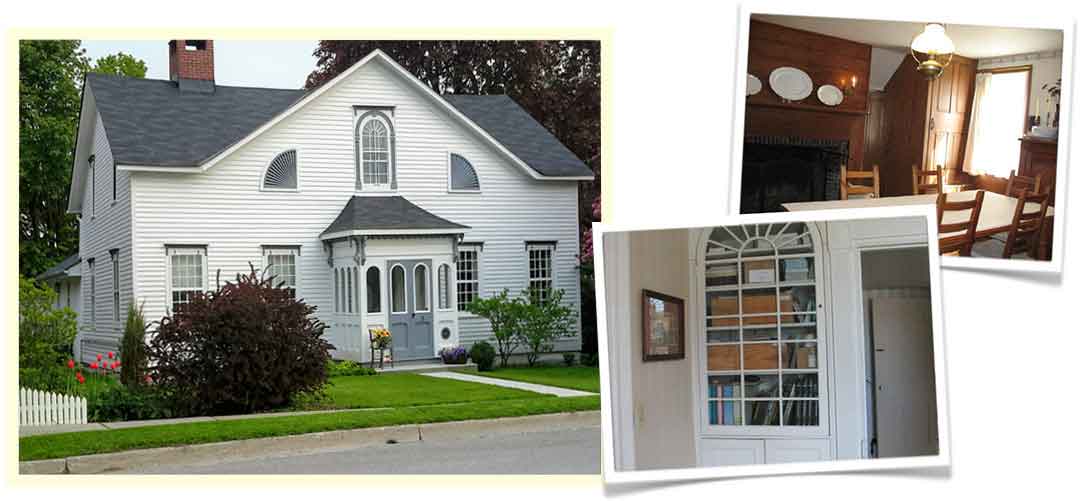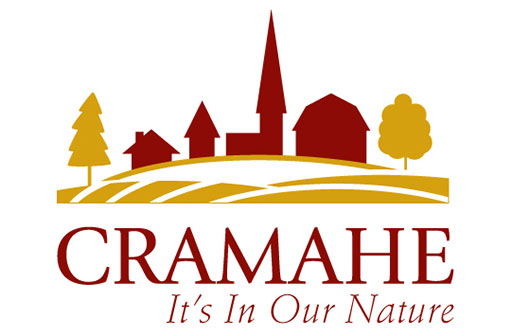3 King Street West, Colborne
(c. 1820 or earlier)
Roll No. 1411-12-030-33400 – Cramahe Township Ontario

Georgian Vernacular – Designated
There is an imposing back to back fireplace with an 8 square foot chimney in the very centre of the original space, which was used for cooking and heating. There are two other fireplaces, one of which is still operational. All are in the Federal style and all are in keeping with the house’s Adams style detailing*. The house has 9 rooms, 9 foot high ceilings, original windows and wood floors, some of which are original. There is a secret passage and several hiding places – the purpose of which is unknown but they are reminiscent of the “Priests’ Holes” of Elizabethan England. The roof is cross gabled, and the house is one and one half stories with a Palladian window lighting the front of the gable. The house is the original wooden, white painted clapboard with moulded overlaps. The windows are original period glass “12 over 12” double hung sash. The gable window is flanked by painted wooden quarter-circle fan details associated with Georgian architecture.
The shed-roofed wooden storm porch with Italianate brackets was a later addition. The single story annex to the rectangular floor plan is probably one of the ubiquitous summer kitchens of the era. There is a period vestibule and the front doorway is modestly detailed by rectangular side and top lights and it has a restrained moulded architrave. (lintel)
*James and Robert Adams (18th c.) were the first to create an integrated look for architecture and decor – walls, floors, cornices, windows, fireplaces etc. were all defined to create the”Adam’s” look.
History or Associative Value
Reputed to be among the oldest dwellings in Colborne, this was the home of Scottish immigrant John Steele and his wife Mary Spalding from 1831-1843. Some feel the house pre-dates 1820. Steele, a founder of Queen’s University held many other posts such as magistrate, newspaper man, Board of Education, Literacy, agricultural societies etc. In 1843, the Steeles moved to Grafton and sold to Cuthbert Cumming in 1845, he sold it in 1858 to the Scougale family who lived there for decades.
Additional Historical and Genealogical Information
Cramahe Township, Concession 1, Lot 32
A lot has already been researched concerning the “Thornton House”, as summarized in the following excerpt from the Cramahe Library website. A lot of this is taken from “How Firm a Foundation” (Argyris, 2000).
John Steele and his wife, Mary Spalding, lived in the house from 1831 to 1843. The registry of land deeds only records the history of the property, not the history of the residence. John Ogden received the grant for this land from the Crown in 1809. The house can be securely dated to 1831 as Mary Steele wrote a letter to a friend in February of that year stating that she hoped to hire a girl to help her with the housework: “My haste must apologize for my abruptness while I say that I would like to get that girl Miss Smith and that I would wish to begin next week with me if possible…I forgot to mention I should expect to pay her out of the store and of course to let her get shoes and the like where we are dealing.” In 1843, John and Mary Steele moved from Colborne to a red brick house beside Mary’s father, Thomas Spalding of Grafton. These twin Georgian houses still stand on Highway 2 in Grafton.
The historical name for the 3 King Street West, is the “Thornton Residence,” although the Thorntons lived in the house for only nine years. The Scougale family and their descendents owned the house for 101 years. The Gordon Brothers Ladies’ Clothing Store was next door with other businesses on the Scougale Block. This one and half storey house is an example of how building styles were influenced by taxation in Ontario of the day. Taxes were based on the number of stories, the number of fireplaces and building materials. This house would have been taxed at the rate of one and a half stories even though there were two full floors.
John Steele founded the Northumberland Pilot, and was also involved with the Watchman, published in Port Hope. He helped found Queen’s Univesity and was a member of its first board. Steele served as Postmaster in 1824, and as a magistrate and chairman of the Newcastle Quarter Sessions. In 1837, he was appointed a member of the Board of Education for the District of Newcastle, and by 1844, he was Superintendant of Schools for the District. He also took part in other local organizations, including agricultural societies, the Canada Literacy Society, Manual Labour and Education Society, and the Northumberland Militia, where he held a captaincy in the 3rd Regiment. A staunch Presbyterian, Steele fought against the establishment of the Anglican Church as the state religion of Canada.
A few more details can be added:
John Steele (1797-1872) purchased the property from Festus Bennett (?-ca. 1851) (LINK), not John Ogden(1762-?) (LINK), on 31 September 1831. Bennett had purchased it, along with most of the rest of the northern half of Concession 1, Lot 32, from Jane Hodges and George and Hannah Kent (LINK) in 1821. Hodges and the Kents had acquired it from John Ogden, although the details of that transaction are obscure. Unlike the modern property at 3 King Street West, the Steele property extended all the way to the eastern edge of Concession 1, Lot 32 (i.e., to the modern location of Division Street, though that street wasn’t there at the time).
John Steele was born in Greenock, Renfrewshire, Scotland in 1797 and immigrated to Canada in 1820. He married Mary Spalding (1804-1854) in Cobourg in 1828. Interestingly, although he is described in the above text as a “staunch Presbyterian” who “fought against the establishment of the Anglican Church as the state religion of Canada”, he was married in St. Peter’s Anglican Church. The Steeles probably arrived in Colborne when they bought the property of interest in 1831, but this isn’t definite from the information available. The information quoted above states that they left Colborne in 1843. If so, they would have lived in Colborne with six of the eight children they eventually had: James Thomas (1833-1901), Anne (1835-1885), John Spalding (1836-1885), Margaret S. (1839-1881), William B. (1840-1912), and Richard Clarke (1843-1910). In fact, all of these children would have been born in Colborne, probably in the house under discussion. The Steeles moved from Colborne to Grafton, and lived also at various times in Cobourg, Port Hope, and Oshawa. John Steele died of “chronic rheumatism and general failure of the vital powers” in Oshawa in 1872 (although some sources say 1876).
The article recently published in Northumberland Today by Charles Beale suggests that John Steele was a business partner of Joseph Abbott Keeler. Nothing has been found to corroborate or refute any of the above comments about Steele’s business and community activities.
John Steele sold the property to Thomas Brown Anderson (1796-1873) and James Bell Forsyth (1802-1869) of Montreal on 15 February 1843. Both Anderson and Forsyth were prominent Montreal merchants who as of 1843 were involved in a trading company called Forsyth, Richmond, and Co. Anderson at the time was the president of the company. He was also on the Board of Directors of the Bank of Montreal and would later become president of the Bank. Clearly Anderson and Forsyth were never residents of Colborne and their interest was in property there is unclear.
Forsyth and Anderson sold the part of the property now occupied by the building on the southwest corner of King and Division Streets to John M. Grover (1815-1888) on 4 March 1845 and the rest of the Steele property (the part with the house on it) to Cuthbert Cumming (1786-1870) on 5 May 1845. The property sold to Grover has no house of interest on it, so it won’t be discussed further here. Cuthbert Cumming is discussed more fully under the Cumming House (7 King Street West). Cumming owned both 3 and 7 King Street West until he sold Number 3 to James Scougale (ca. 1824-1890) on 2 March 1858.
James Scougale was a carriage maker who emigrated from Scotland. He married Mary Ann Robson (1828-1906) and had five children: Adam (1859-1922), John R. (1861-1932), Isabella V. (1863-?), James Andrew (1866-1927), and Andrew George (1868-1944). All five of these probably would have been born in the house at 3 King Street West. When James died in 1890 of “heart failure and paralysis of the brain”, the property was inherited by his widow. A few months before she died in 1906, she transferred it to her eldest son, Adam. Adam, who never married, continued to own the property through the cut-off date of 1921. He died in 1922 of “pulmonary tuberculosis secondary to diabetes mellitus”. Adam Scougale was a dry goods merchant. In the 1880’s he had a business called Scougale and Carter (with Matthew J. Carter, 1857-1958). In the 1890’s his business was Scougale Bros. The Scougale brothers referred to would have been James (occupation dry goods in 1891) and Andrew (occupation bookkeeper in 1891). The third brother, John, was a harness maker. Adam ended up running the dry goods business by himself: as of the 1921 census all three of his brothers were living in Dawson in the Yukon Territory.
Although Percy Bruce Thornton (1880-1945) was a Presbyterian minister in Colborne from 1908 to 1913, he probably didn’t live in the house at 3 King Street West prior to the 1921 cut-off. Apparently after spending some time in China, he returned and married into the Scougale/Robson family and lived in the house in later years.
When was the house built? It is unknown where John Ogden lived, but the first land he cleared was along the lake shore and likely he lived there rather than at “Four Corners”, which didn’t even exist as a road junction until the first decade of the 1800’s. Similarly, it is unlikely that Jane Hodges and George Kent lived elsewhere in Cramahe. It is more likely that Festus Bennett lived there, but he and his family continued to own most of the northern half of Concession 1, Lot 32 after he sold the property at 3 King Street West to John Steele in 1831. It doesn’t seem particularly likely, though not impossible, that he sold the house he was living in to someone else, while retaining the majority of his land. It’s more likely that he lived elsewhere on that land. We know that John Steele lived on the property at 3 King Street West and it is pretty clear that Thomas Brown Anderson and James Bell Forsyth did not. How Firm a Foundation suggests that the house was built in the early 1820’s. If true, the house was there for the better part of 10 years before the Steeles moved in and it would therefore have to have been built by Ogden or Bennett (or possibly Hodges or the Kents). If it’s not that old, Steele may have had it built himself.
What about Cuthbert Cumming? We know that he lived in house next door (7 King Street West) for most of his time in Colborne, but it is interesting to note that he bought the property at 3 King Street West on 5 May 1845, over a year before he bought the one at 7 King Steet West on 15 October 1846. Did Cummings live briefly next door at 3 King Street West before moving to Number 7?
The Scougales definitely lived in the house after 1858, and they apparently remained there through 1921.




